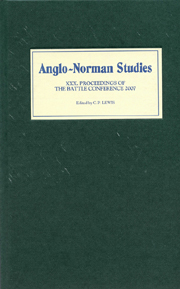Book contents
- Frontmatter
- Contents
- LIST OF ILLUSTRATIONS, MAPS, AND TABLES
- EDITOR'S PREFACE
- ABBREVIATIONS
- The Normans in Welsh History (R. Allen Brown Memorial Lecture)
- William Marshal, Lancelot, and Arthur: Chivalry and Kingship
- Grades of Ordination and Clerical Careers, c. 900–c. 1200
- Evesham J and Evesham L: Two Early Twelfth-Century Manorial Surveys
- Aspects of Church Reform in Wales, c. 1093–c. 1223
- Lay Charters and the Acta of Henry II
- Reinventing Normans as Crusaders? Ralph of Caen's Gesta Tancredi
- Kings, Lords, Charters, and the Political Culture of Twelfth-Century Wales
- Identifying the Warrior on the Pre-Heraldic Battlefield
- St Nicholas the Pilgrim and the City of Trani between Greeks and Normans, c. 1090–c. 1140
- The ‘Resurgence’ of Powys in the Late Eleventh and Early Twelfth Centuries
- Interpreter Families and Anglo-Welsh Relations in the Shropshire-Powys Marches in the Twelfth Century
- A Taste for the Antique? Henry of Blois and the Arts
Reinventing Normans as Crusaders? Ralph of Caen's Gesta Tancredi
Published online by Cambridge University Press: 12 September 2012
- Frontmatter
- Contents
- LIST OF ILLUSTRATIONS, MAPS, AND TABLES
- EDITOR'S PREFACE
- ABBREVIATIONS
- The Normans in Welsh History (R. Allen Brown Memorial Lecture)
- William Marshal, Lancelot, and Arthur: Chivalry and Kingship
- Grades of Ordination and Clerical Careers, c. 900–c. 1200
- Evesham J and Evesham L: Two Early Twelfth-Century Manorial Surveys
- Aspects of Church Reform in Wales, c. 1093–c. 1223
- Lay Charters and the Acta of Henry II
- Reinventing Normans as Crusaders? Ralph of Caen's Gesta Tancredi
- Kings, Lords, Charters, and the Political Culture of Twelfth-Century Wales
- Identifying the Warrior on the Pre-Heraldic Battlefield
- St Nicholas the Pilgrim and the City of Trani between Greeks and Normans, c. 1090–c. 1140
- The ‘Resurgence’ of Powys in the Late Eleventh and Early Twelfth Centuries
- Interpreter Families and Anglo-Welsh Relations in the Shropshire-Powys Marches in the Twelfth Century
- A Taste for the Antique? Henry of Blois and the Arts
Summary
In many respects Ralph of Caen had the most ‘Norman’ credentials of any historian of the First Crusade, since his family hailed from Caen or near by and he shared a tutor, Arnulf of Chocques, with the sister of Duke Robert II of Normandy. Although Guibert of Nogent was scornful of Arnulf's talents, Ralph seems to have been particularly well educated, especially in the classical poets and historians. Ralph did not accompany Arnulf on the First Crusade, but joined the entourage of Bohemond of Taranto during his recruitment tour of France in 1106, and taking part in the crusade expedition of 1107 as a chaplain. Later he travelled to the Holy Land and served Bohemond's relative Tancred in Antioch, but after Tancred's death in 1112 he sought out the patronage of his old tutor Arnulf, now patriarch of Jerusalem. He started writing the Gesta Tancredi around that time, possibly while a canon of the cathedral church in Jerusalem, and dedicated it to Arnulf at some point before the patriarch died in 1118 Ralph's training in Normandy, his participation in the 1107 crusade, his close contact with the First Crusade leaders, and the time he spent in the settler societies of Antioch and Jerusalem all meant that he was extremely well placed to write a history which was largely original and independent of other accounts. Why, then has he hitherto received so little attention, both from historians of crusading and in the ongoing debate about Norman identity?
Much in Ralph's history deserves reappraisal, but this article will focus primarily on its contribution to the debate about Norman identity on the First Crusade. The Gesta Tancredi was not just a fanciful eulogy of Tancred and his Guiscardian heritage: contrary to the opinion of some recent studies, it provides a wealth of information about a transitional period for the Norman image.
- Type
- Chapter
- Information
- Anglo-Norman Studies 30Proceedings of the Battle Conference 2007, pp. 117 - 132Publisher: Boydell & BrewerPrint publication year: 2008



